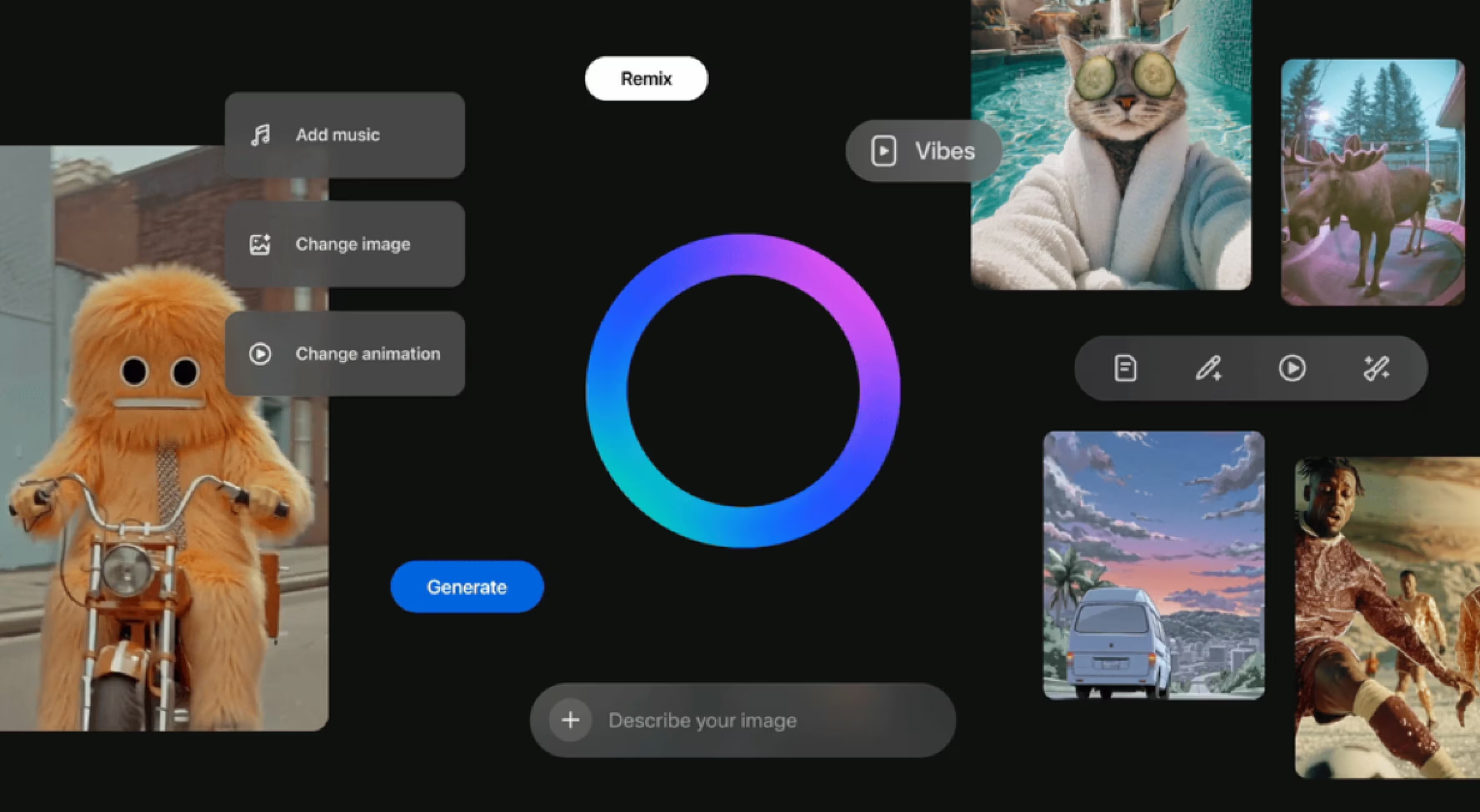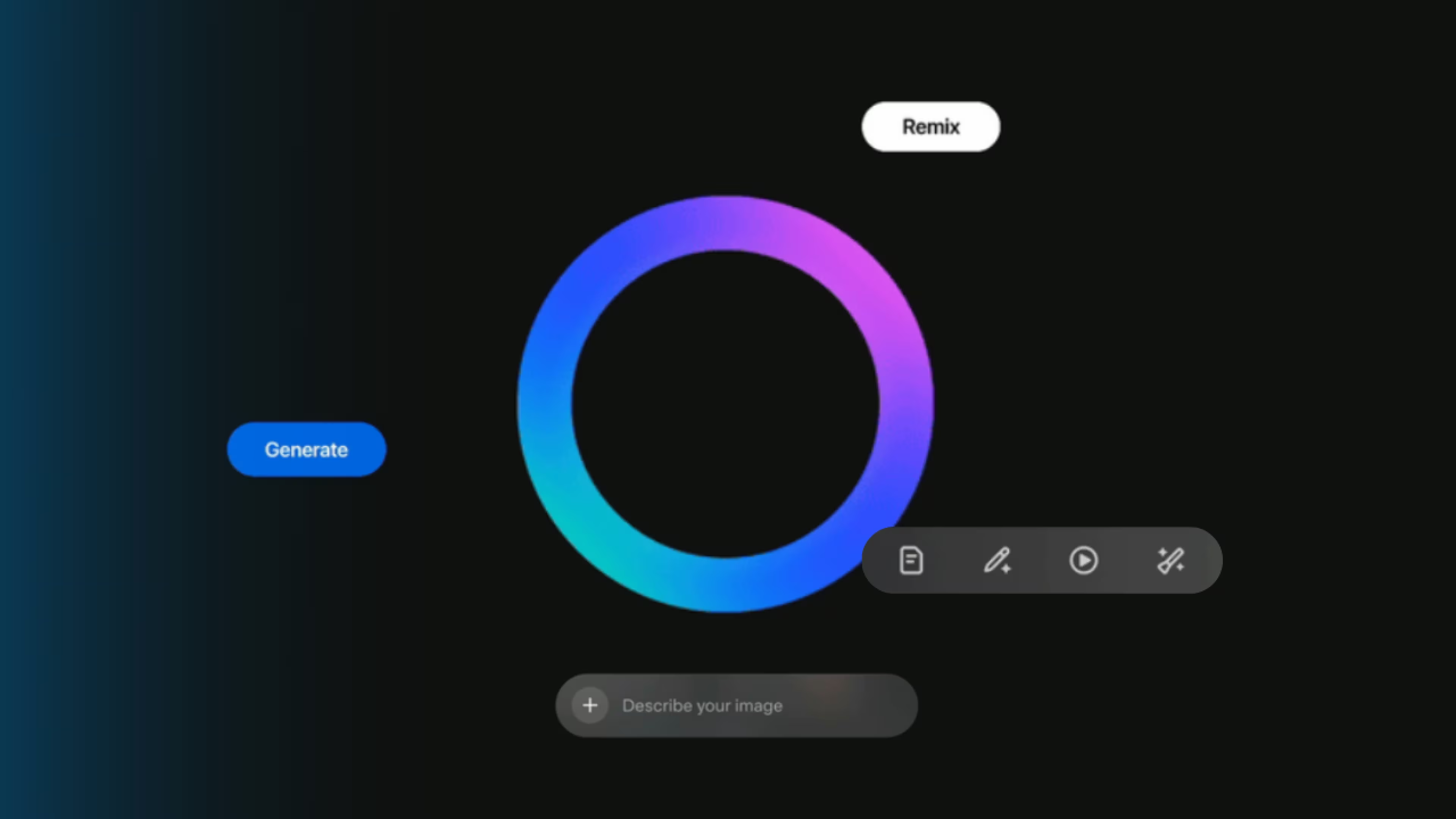Meta's new AI video feed is already changing user behavior. Since launching Vibes on September 25, 2025, the Meta AI app saw a 15.58% increase in daily active users while competitors like ChatGPT and Perplexity experienced declines, according to TechCrunch's analysis.
Vibes creates, remixes, and shares short-form AI-generated videos that cross-post directly to Instagram Stories and Reels. For marketers, this opens a new content channel where production costs drop dramatically and remix culture could amplify brand reach.
What the Meta Vibes AI Video Feed Does
The meta vibes ai video feed lives inside the Meta AI app and on meta.ai. Unlike TikTok or Instagram Reels where humans film content, every Vibes video is AI-generated using text prompts.
Key features:
- Remix Culture: Users grab existing videos and transform them,,changing music, visual styles, or elements before republishing. A single brand video could spawn dozens of customer remixes.
- Cross-Platform Publishing: Finished videos export directly to Instagram and Facebook. Content created on Vibes reaches Meta's 3+ billion users immediately.
- Transparent Prompts: Each video displays the exact text prompt that created it, helping users learn generation techniques.
- Third-Party Models: Meta currently uses Midjourney and Black Forest Labs alongside its own AI systems, suggesting lower per-video costs than competitors like OpenAI's Sora (approximately $1 per video).
Why Video Marketers Should Pay Attention
1. New Advertising Space Expected
While Meta hasn't announced advertising options yet, they're likely inevitable given the 15.58% user growth in three weeks. Early experimentation now means understanding what works before the space gets crowded and potentially before ad costs rise.
Test which AI-generated styles resonate with your audience while organic reach is still accessible.
2. UGC Strategy Gets Faster and Cheaper
Traditional video production requires filming, editing, actors, and equipment. AI-generated videos need only prompts and iteration time.
User-generated content already drives 28% higher engagement than branded content, and 79% of people say UGC impacts their buying decisions, according to Insense's UGC statistics research.
When customers create AI videos featuring your products, you get hybrid content combining UGC's trust factor with polished visual quality. However, authenticity concerns remain real, user response to Vibes has been mixed, with top comments including "gang nobody wants this."
Test your audience's receptivity before committing significant budget.
3. Production Speed Increases Dramatically
Need 10 variations of a product demo? Generate them in an afternoon instead of weeks. This speed matters for trend response, A/B testing, and seasonal content.
The challenge: tracking performance. When you cross-post AI-generated content from Vibes to Instagram Reels and Facebook Stories, you need to track how those videos perform compared to traditional content. Manual reporting across Meta's platforms becomes overwhelming when testing multiple variations. If you're already tracking Meta Ads performance across multiple placements, you can monitor your cross-posted Vibes content through Instagram and Facebook metrics. Tools like Dataslayer automate this for Meta platforms when you're pulling data from multiple sources.

4. Quality Expectations Aren't Set Yet
Vibes content has that distinctive AI look, fuzzy textures, physics that feels slightly off. Audiences don't yet know what "good" AI video looks like on this platform, creating opportunity for early creators to establish standards.
OpenAI's Sora produces near-photorealistic video but launched invite-only due to high generation costs. Meta's wider accessibility gives more marketers immediate testing opportunities.
What This Means for Different Marketing Roles
- Content Strategists: Plan how AI-generated content fits your overall content mix. Test whether your audience embraces or rejects AI video. Consider creating prompt libraries that maintain brand consistency.
- SEO Specialists: Watch how AI-generated video content affects organic reach on Instagram and Facebook. Early data suggests Meta's focus on views as a primary metric may give video content (including AI-generated) algorithmic advantages.
- PPC Specialists: Monitor for when Meta introduces paid advertising within Vibes. Early testing of organic AI content now builds knowledge for future paid campaigns at potentially lower costs than traditional video production.
- Influencer Marketing: Consider how AI tools change creator economics. If anyone can generate polished video content with prompts, what differentiates human creators? Authenticity and personality may become more valuable, or AI-assisted creation may become the new standard.
Practical Testing Framework
- Week 1: Download the Meta AI app. Scroll Vibes for 30 minutes to understand performance patterns. Generate 5 test videos related to your product category.
- Week 2: Cross-post your best performers to Instagram Stories. Compare engagement against your traditional content. Note audience comments, are they positive, negative, or confused about AI content?
- Week 3: Build a prompt library of what creates on-brand results. Test remixing popular videos in your category.
- Week 4: Analyze results from your Instagram and Facebook cross-posts. Which visual styles worked? Did AI content outperform or underperform traditional video? What's your true cost per result factoring in time savings? You can pull this data manually from Meta Business Suite, or automate it with tools like Dataslayer if you're tracking multiple campaigns across Meta's platforms.
Questions Marketers Are Asking
Will AI content damage brand authenticity?
It depends on positioning. Tech-forward brands might strengthen their image by embracing AI early. Brands built on craftsmanship or human connection risk backlash. The key is transparency, don't try to pass off AI content as human-created.
What about copyright?
The legal framework is still developing. Meta's AI models are trained on existing content, raising intellectual property questions. Review Meta's terms of service and consider legal counsel for paid campaigns. If using customer-created remixes, get explicit permission before incorporating them into advertising.
How does this compare to Sora?
OpenAI launched Sora in early October with higher video quality but invite-only access due to generation costs. Meta's partnerships enable wider distribution. Test both platforms to see where your audience responds better.
What to Watch Next
Meta will likely introduce paid advertising within Vibes in coming months. The personalization algorithm will evolve, understanding how it surfaces content matters for organic reach.
As Meta develops its own video generation models to replace third-party partnerships, quality should improve. Watch for tighter integration between Vibes and Instagram/Facebook, potentially allowing AI remix features directly within those apps.
The Bottom Line
The meta vibes ai video feed represents experimental territory. User response is mixed, but 15.58% growth indicates real interest. Smart strategy means small-scale testing now while the platform is uncrowded.
Generate a few videos. Cross-post to Instagram. Track results against traditional content. If your audience responds positively, scale gradually. If they don't, you've learned something valuable about their preferences.
The opportunity isn't replacing your video strategy with AI content. It's finding specific use cases where AI generation provides advantages, like speed, cost, and variation testing, that complement your human-created content.
Video marketing evolves rapidly. Platforms like Vibes will either become essential channels or cautionary tales. Understanding how they work and whether your audience responds puts you ahead of marketers who ignore them entirely.
.avif)
FAQ: Meta Vibes AI Video Feed
What is the Meta Vibes AI video feed?
Vibes is a dedicated feed within the Meta AI app and on meta.ai where users create and share short-form videos generated entirely by AI. Launched September 25, 2025, users enter text prompts and AI models (Midjourney, Black Forest Labs, and Meta's own systems) generate videos. The remix feature lets anyone modify existing videos' style, music, or elements before republishing. Videos cross-post directly to Instagram Stories and Facebook Reels.
How can marketers use Vibes for campaigns?
Current opportunities include creating AI-generated product videos at lower production costs, running remix campaigns where you launch a brand video and encourage customer remixes, building prompt libraries for consistent brand content, and testing which AI visual styles resonate with your audience. Meta hasn't launched formal advertising features yet, so focus on organic experimentation while learning what works.
How does AI-generated content perform compared to traditional UGC?
Traditional UGC drives 28% higher engagement than branded content because 79% of consumers say it impacts buying decisions. AI-generated content on Vibes looks more polished but may lack raw authenticity. When customers use Vibes to create AI videos featuring your products, you get hybrid content combining trust factors with higher visual quality. However, audience reception varies significantly by demographic and brand category, test both approaches rather than assuming AI content will match human-created UGC performance.
Need to track your cross-posted video performance on Instagram and Facebook? Try Dataslayer free for 15 days to automate Meta reporting in Google Sheets, Looker Studio, BigQuery, or Power BI.







